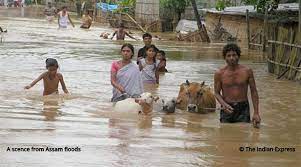Animal Welfare During Natural Calamities and Disaster Management
The world health organization (WHO) defines a disaster as any occurrence that cause change destruction, ecological disruption, loss of human life, human suffering, deterioration of health and health serves on a sale sufficient to warrant an extra ordinary response from outside the affected community or area.
Strategies for management of live stock in disaster prone areas Main problems which are seen during disaster are spoilage of food or water supply, zoo noses, reduced dairy and livestock production due to scarcity of feed and water, high livestock mortality rates, physical injury and spread of diseases.
BASIC RULES FOR ANIMAL PROTECTION DURING DISASTERS
1) Veterinarians and animal protection expert should be included in disaster assessment teams and heir advice used in community disaster planning.
2) Involvement of animal care groups like ( IWGASD) international working group on animals in disasters to provide shelter, rescue and veterinary care.
3) Provision of basic stray animal awareness training to humanitarian aid workers for safety reasons.
4) Joint training between animal care and humanitarian relief works to ensure an approach to disaster management that saves both people and animals at least cost.
5) Policy makers should take into account practical indigenous techniques and economic, trade or social restrictions.
II) Housing Management :
a) Animals should be kept under shade of tress.
b) No overcrowding of animals in hard.
c) Iron sheet proof should be covered with thatch or asbestos sheet.
d) Upper layer of Kachha floor should be replaced with new and at every six months interval, so that load of organism can be reduced.
e) Spots closer to temple, churches, masjids are generally ideal for temporary drought relief camp.
III) Feeding Management :
a) Animals Should be allowed to graze and feed in early morning or late evening only.
b) Management of good stocking rates in pasture land.
c) Grow drought resistant plants and rear drought resistant livestock.
d) Application of fodder conservation technique e.g. molasses treatment
IV) Water Management :
1) Lactation & pregnant animal must be given priority over young and bullock, crossbreed over local breeds & sick animal over healthy.
2) Avoid wastage of water
3) Restrict salt intake
4) Water show be mixed with gur/jaggery as it satisfy the thirst.
5) Provided water in small quantity and move frequently.
6) Water conservation during rainy season ( dams and ponds)
V) Caring for Livestock during disaster
First priority should be personal safety & welfare followed be the safety and welfare of other people & finally animals & property. first logical steps in caring for livestock and other animal is to locate, control and provide for these animals. If difficult to find, contact local law enforcement for information. Shifting of animals during flood.
VI) Sensitivity :
Very often disaster temporality after the behavioral state of livestock as they get agitate, nervous so follow some technique.
1) Handle with quietly, calmly manner in which they are familiar
2) Wear clothing and use vehicles that are familiar.
3) If possible clean the animal (wipe out eyes, mouth, nostril)
4) Move animals away from the residue of disaster
5) Treat wounds of injured animals so their comfort level improves.
VII) Feed, Safety & Shelter
Over the last few years the major calamity prevailing was drought in central portion of India, Rajasthan, Gujarat, Maharashtra & Deccan plateau due to deficient of monsoon rainfall, also in some southern states like Karnataka & Tamilnadu. Feed scarcity is major problem during last few years so to overcome this
1) Drought resistant vegetations in combination with NPN source of protein and byproducts of sugar industry molasses as source of energy could be used for meeting immediate nutritional requirement.
2) Tree leaves and cakes of inedible oilseeds could be used to meet the essential requirement of intact protein in ruminants.
3) Cattle relief camps were set up around sugarcane factories in drought affected zones
4) Large scale feeding of bagasse, molasses in combination with urea and mineral supplements were adopted.
5) Feed formulations developed.
VIII) Proper animal evacuation policy rules
1) Provision of adequate resources to evacuate animals
2) Sanitation and safety considerations to restrict animals from camps
3) Animal welfare professionals should co design with humanitarian community policies and procedure
IX) Disease prevention and control
1) Provision of advice on basic health and hygiene requirements for livestock management and movements
2) Transfer of knowledge from trained professional to other people
3) Slaughter of infected animal carried out humanely
4) Vaccination schedule should be followed
X) Proper carcass disposal
1) Burying : Deep pit of 8-9 feet, use of quicklime, common salt and other disinfectant
2) Burning : 4 cm diameter and 1M tall pit should be used
3) Cross trench pit : Gallon of kerosene or old rubber tyres are used.
Compiled & Shared by- This paper is a compilation of groupwork provided by the Team, LITD (Livestock Institute of Training & Development)
Image-Courtesy-Google
Reference-On Request
DISASTERS AND ANIMAL WELFARE
Handbook for Management of Animals in Disasters & Emergencies
Handbook for Management of Animals in Disasters & Emergencies_compressed
DISASTERS AND ANIMAL WELFARE_compressed




